Aquair 100 Hybrid Wind & Water Generator
Towed turbine generator for yachts, with wind conversion kit
|
The most effective means of generating electricity to recharge 12v/24v batteries at sea.
Generates approx. 1 amp per knot (12v) at average cruising speeds.
Rope transmits power of spinning turbine to on-board generator.
Gimbal mounting of generator gives fool-proof operation & long-life.
Simple installation from stern rail - no permanent hardware. Easily rigged.
Thousands in use worldwide. Hundreds of circumnavigations made.
Highly suitable for use on long distance blue water cruising yachts.
Wind turbine conversion available for use at anchor.
|
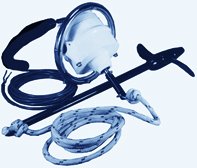 |
The Aquair pedigree
Proven over thousands of miles of ocean cruising. Reliability is achieved by using a towed turbine on a 30 metre line directly coupled to the alternator shaft. Totally sealed alternator. Stainless steel gambol ring provides a simple and automatic alignment method.
Built to professional standards for long term endurance and backed by full manufacturers warranty. The Aquair 100 is constructed of marine grade materials for minimal maintenance. Only a spare turbine is recommended to cater for accidental loss. Electrical contact is direct to the battery using a simple on/off control switch.
Advantages of the hybrid system - why water drive and wind drive
An Aquair greatly reduces the frequency of engine running to recharge service batteries. The Aquair 100 generates sufficient power to run an autopilot, maintain navigation equipment or support a fridge. Produces a continuous output up to 7 Amps at 12 volts. Permanent magnet alternator, has no commutator brushes, windings cannot overheat so requires no thermal cutouts or protection choke.
The Aquair 100 is a towed turbine generator when sailing and a wind driven generator when at anchor. The reason for the choice is that when sailing downwind at 6 knots, the Aquair 100 Water Drive generates approx. 5 amps continuous charge. Contrast this with the fact that to obtain 5 amps of generation from the wind driven version while underway, the wind speed required is typically 30 knots (24 knots plus 6 knots boat speed) and you can see why long distance cruisers prefer water drive for reliable continuous power. And when the boat is at anchor or in harbour just rig the generator in Wind Drive - either on the pole mount kit or using the hoist in rigging kit, and have all the advantages of a wind turbine.
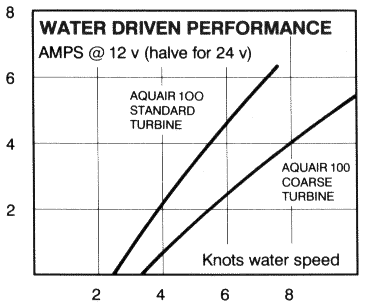 |
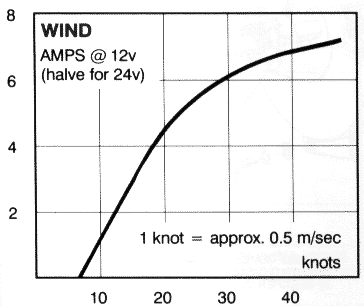 |
Aquair output in water mode
|
Aquair output in wind mode
|
Aquair Stern Deck Mount
| Suitable Stainless Steel fabrication to accommodate the Aquair 100 gimballed generator on yachts without a suitable push-pit e.g. those with canoe sterns, rails separated by less than 300mm and many multi-hulls |
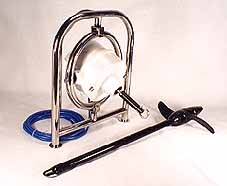 |
Aquair 100 Hoist in rigging kit & Pole mount kit for wind charger option
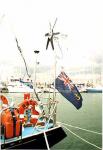 |
There are two Aquair 100 kits to convert the towed turbine generator to wind charger for battery charging at anchor. Conversion consists of a 6-blade wind turbine, direction fin plus top & bottom swivel poles or pole & pole mount assembly. This enables the Aquair 100 to be hoisted in the rigging or stern mounted for use at anchor. |
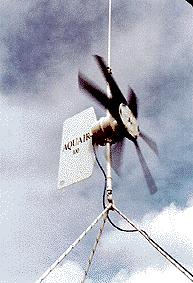 |
|
Pole mount kit
|
|
Hoist in rigging kit
|
Aquair 100 generator technical description
5m of 2-core cable (1.5mm2 core area) connects the Aquair generator to the battery. This can be terminated direct to the battery, but we suggest wiring through a switch, fuse and ammeter (10 Amp for 12v, 5 Amp for 24v) and also the use of a through deck plug and socket. A second deck socket should be considered for fore-triangle hoisting of the wind version. A cable extension up to 5m can be made using the same wire. Operating a towed generator with the switch in the open (off) position will not damage the unit but will generate a high open-circuit voltage, which must be treated with due care. The Aquair 100 generator features built-in rectifiers which convert AC to DC and block reverse current flow, while the permanent magnet alternator can even charge a totally flat battery. The special two bladed turbine is streamed behind on a high strength line which transmits the rotation of the turbine to the generator (in much the same way as a trailing log does). A safety break-link connects the rope directly to the alternator shaft which protects the generator and fixing point in the event of a fouled turbine. A combination of line length and the weight of the stainless steel turbine shaft, prevent the turbine skipping in normal sea states whilst limiting drag to produce only minimal speed loss (between 1/3 and 1/2 of a knot for yachts of 30ft/9m and over).
Turbine surfacing occurs at 7-8 knots for the standard pitch unit and 12 knots for the coarse pitch. The slower speed of the latter reduces output by over 50% below 7 knots. Less drastic adjustment can be made by increasing the tow line diameter and length or by adding sinker weights to the turbine. Frequent skipping caused when a larger yacht surfs down waves in heavy seas can lead to the turbine tangling with its own rope. A short length of hose over the rope will help prevent this. Shorter tow lines of 20 metres are usable on smaller yachts which typically sail at about 6 knots maximum speed. Generally, it is necessary to slow to retrieve the turbine and line, otherwise hauling it in hand over hand is difficult, due to its spinning power. Once on board, the line must be restreamed without the turbine to unwind the twists and kinks.
Ampair & Aquair 100 watt charge control regulators
AMPAIR manufactures three 100 watt power Charge Control Regulators in 12-volt or 24-volt options for protecting lead acid batteries from overcharge They are not "shunt" type regulators, which dissipate excess charge as heat, but an electronic power switch which disconnects the generator from the battery at the regulation voltage.
Choosing an Ampair 100W charge control regulators
| Model |
Voltage |
Number of inputs
(Aquair, Ampair, or solar) |
Number of outputs
(battery banks) |
| S-1B-12 |
12 volt |
One |
One |
| S-1B-24 |
24 volt |
One |
One |
| S-3B-12 |
12 volt |
One |
Three |
| S-3B-24 |
24 volt |
One |
Three |
| D-1B-12 |
12 volt |
Two |
One |
| D-1B-24 |
24 volt |
Two |
One |
| Regulators S-lB & S-3B have a single 100 watt input (Ampair, Aquair or Solar) and 2 level sensing. Regulator type S-M1B has one output battery connection asnd regulator S-M3B has three output connections to serve up to three battery banks. The third Regulator D-M1B has two 100Watt inputs (any two from Ampair, Aquair or Solar), supplying a single battery bank at a fixed regulation voltage. |
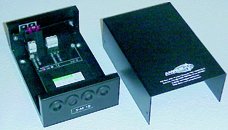 |
Advanced operation of Ampair charge control regulators
| Ampair charge control regulators continuously monitor the battery voltage. The lower voltage (Lo) connection regulates at 0 4 Volts below the high (Hi) connection, "Hi" connection is appropriate for liquid electrolyte batteries and/or live aboard situations. "Lo" connection for gel batteries and/or infrequent use. The battery voltage is sensed at the regulator output connection therefore install the regulator as near the battery as practicable and keep the connecting cables short. All regulators feature the same multi-stage regulation programme which has regulation voltages of Lo = 13.6v Hi = 14.0v. for 12V systems (27.2V & 28V for 24V systems). Charging is continuous until the Lo or Hi voltage is reached, depending on the battery output used. The generator is now disconnected from the battery. Off-charge, the battery voltage will fall. At a voltage of 0.5V below the regulation voltage a 30 second time delay is activated. This delay prevents the regulator from oscillation (hunting) when charging batteries under load. |
 |
| After 30 seconds has elapsed the generator/battery connection is remade and charging continues to the regulation cut-out voltage. A cycle counter counts the charge/disconnect cycles and at the tenth cycle increases the regulation voltage for one cycle only by 0.4 volt to Lo = 14.0v or Hi = 14.4v for 12 volt systems (0.8V for 24V systems Lo = 28.0V, Hi = 28.8V). This provides an equalisation charge for the battery. Subsequent cycles return to the lower settings until a further 9 cycles are completed. |
Ammeter: We recommend fitting an ammeter (see our price list) to monitor charging.
Fuses: Battery protection fuses should be fitted. Use 10 Amp values in 12 volt systems, 5 Amp for 24 volts
|